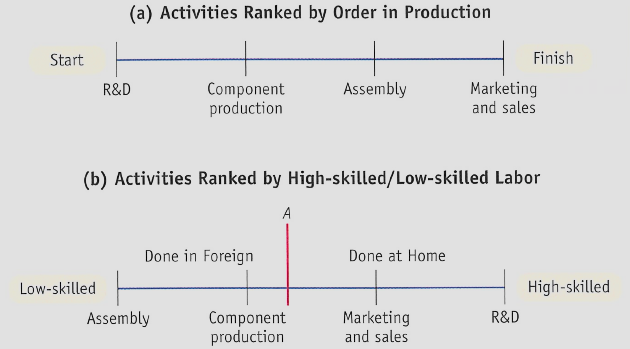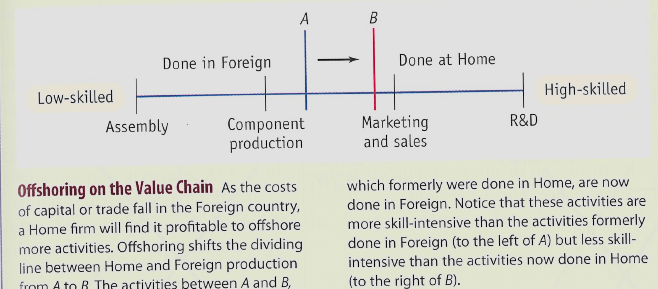Unbundling and the global value chain
TiVA analysis
August 21, 2024
Who am I
Full-time lecturer di Politeknik APP, part-time di Universitas Indonesia, Associate researcher di Center for Indonesian Policy Studies.
Master degree in economics at UI/VU (2014), PhD in economics at ANU (2022).
Research mainly in trade in industry.
web at krisna.or.id
So far
we have discusses extra-industry trade, where countries are buying and selling different goods (e.g., cloth exporter and food exporter)
- can be driven by difference in technology or factor abundance.
Trade in final goods are basically using the global resources to full efficiency.
- in this case, using trade data is enough to analyze, and tariff use is much simpler.
That, until the Global Value Chain (GVC) went mainstream.
Today
Today we discuss the concept of offshoring.
We also unpack the concept of unbundling stages of production.
We’ll have a look at TiVA data and making sense of it.
No more aeroplane countries

Offshoring
The provision of a service or the production of various parts of a good in different countries that are then used or assembled into a final good in another location is called foreign outsourcing.
- sometimes called offshoring.
Offshoring is a typoe of international trade that differs from the type we see in Ricardian and H-O models where goods traded are final goods.
Offshoring is trade in intermediate inputs, which can sometimes crosses several borders before turned into a final good.
Offshoring
At its core, offshoring has the same reasoning as our standard trade model:
- A firm in a country is better of sourcing part of their production in countries with comparative advantage in that good.
In essence, offshoring breaks down a final good into several intermediate goods (and services).
- these goods embed different factor intensities.
Unbundling
To understand offshoring better, we utilise the theory of product unbundling, coined by Richard Baldwin.
So far, our model assume a trivial trade cost. which is of course far from true in the real world.
However, trade cost is indeed dropping in various speed.
Decreasing cost of trade is what causes economic undbundling.
Cost of trade
trade cost / cost of moving goods leads to the first unbundling.
communivation costs / cost of moving ideas leads to the second unbundling
Face-to-face costs / cost of moving people leads to the third unbundling.
First unbundling
Happened in around 1820, the brittain industrial revolution
- aka the steam revolution -> steam ship, steam rail, containerization, telegram/telephone.
Also the Pax Brittanica, a relatively peace time after Napoleonic war.
Characterized by low trade cost, but high communication costs and face-to-face costs.
First unbundling
also called old globalization.
With high trade cost, all countries must produce their own goods and services because moving goods are expensive.
The first unbundling is basically unbundle production and consumption: various goods can be produced abroad.
Production clustered locally (to reduce communcation costs), but market are global (goods can be moved to different countries relatively cheaply)
- also, remember internal economies of scale?
Old globalization
High communication costs meant Northern (aka rich countries) innovation stayed in the north.
There is a knowhow imbalance, where all the knowledge is accumulated in the place of productions (remember external economies of scale?)
Second unbundling
Happened after 1990 thanks to ICT revolution (basically the internet).
Characterized by low cost of trade and communication cost, but still high face-to-face costs.
Now firms can organize production easily. Location of ideas can be different from the manufacturing.
2nd unbundling: unbundling process of production / production value chain.
Second unbundling
The second unbundling creates hyperglobalization, where globalization happens on the process of production.
- This is offshoring. Also called the global value chain (GVC) phenomenon.
To ensure offshored production meshed seamlessly, G7 firms offshored knowhow with the jobs.
This creates a comparative advantage, hence trade opportunities from high-tech value chain and low-wage one.
With lower value outsourced (hence gets cheaper with lower wage), the trade cost become worth it.
Modeling the offshoring
For any given final product, we unbundle its process of production. We first list these process from start to finish.
For example, to make an aeroplane, you need to start with research and development (R&D), produce components, assemble them, and then do marketing and sales as well as customer service.
We then rearrange the list in terms of value: from lower value to higher value.
- e.g., start with assembly, end with R&D.
Modeling the offshoring

Offshoring model
panel (a) is the unbundle list based on production process, while panel (b) is the rearranging from lower value to higher value.
In the panel (b), there exists a point A where we can slice/unbundle the production process: a low-value process (left of A), and a high-value process (right of A).
Suppose Home country is a high-tech country, then it’s better for home to outsource the left bundle abroad.
Offshoring
This is the second unbundling: we unbundle process of production into two: high-value bundle and low-value bundle.
Two countries with different labor profile then trade these bundles.
Just like Standard Trade Model (STM), we can model this with a relative wage vs relative labor demand graph.
Lower trade cost

Second unbundling
The new ‘hi-tech-low-wage’ mix shifted manufacturing & knowhow massively to a handful of developing nations.
The result is the great convergence between 1990-2014:
Developed countries are catching up, enlarging their pie share in the global GDP.
While G7 economies relatively reduced in the global GDP share.
Consequences
New globalization (aka the second undbundling) breaks monopoly that G7 labour had on G7 knowhow. Now G7 firms can pick other labor in other countries basically.
New globalization affects economies with finer resolution: it used to be that countries compete on the final product level, now on the manufacturing stage and job level.
Impact of the new globalization is now more sudden, individual, unpredictable and uncontrollable.
Consequences
production that used to be happened all in one country is now become an international trade.
Trade policy affects not just final product, but also granularry
Predictable trade policy become even more important because changes in one chain of value affects the overall production.
National competitiveness is now become regional competitiveness.
Consequences
Developing countries now don’t have to start to build final good from the ground-up. They can join the value chain / production network.
Vietnam is one of the largest smartphone exporter. It does not have to know how to make the whole smartphone, but starting from the assembly.
China also started with assembly and then become more upstream
G7 competitiveness now relies on offshoring. Cannot compete without one.
Analytical consequences
Trade data is no longer useful if large components are sourced from import.
You can know how much salt we import, but it’s much harder to know who use them: end consumers? food industry? Chemists?
The value of a country’s export may be doublecounted: Vietnam is not making phones. Just assembling.
This is where TiVA comes in.
TiVA
GVC in the food industry

GVC in semiconductor

The third unbundling
Third unbundling is a relatively new phenomenon: happens when face-to-face cost reduce.
The industry 4.0: face-to-face cost reduces thanks to telepresence and telerobotics. Data transfer, human-machine and machine-machine interface allows it to happen.
Services and digital trade is taking the front stage. A story for another time.
